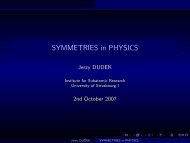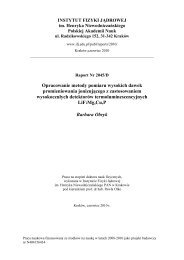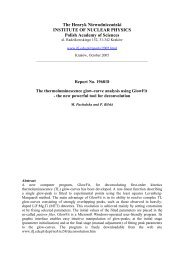Report No 1951/AP - Instytut Fizyki JÄ drowej PAN
Report No 1951/AP - Instytut Fizyki JÄ drowej PAN
Report No 1951/AP - Instytut Fizyki JÄ drowej PAN
You also want an ePaper? Increase the reach of your titles
YUMPU automatically turns print PDFs into web optimized ePapers that Google loves.
WATER BOUND IN ANTARCTIC LICHEN Usnea antarctica AS OBSERVED<br />
BY PROTON RELAXATION AND SORPTION ISOTHERMH.<br />
Harańczyk 1 , A. Pietrzyk 1 , and 2 M.A. Olech<br />
1 Institute of Physics and 2 Institute of Botany, Jagellonian University, Cracow<br />
In search of dehydration limits of living creatures, the attention is focused on species<br />
populating habitats experiencing the extremely low hydration and/or decreased temperature.<br />
Among them the Antarctic lichens are a good example. In contrast to vascular plants which<br />
stop their photosynthetic activity during winter, lichens can be photosynthetically active and<br />
productive even if the tissue is frozen.<br />
A fundamental for understanding the molecular mechanism of the metabolic activity<br />
recovery during rehydration is knowledge about the number and distribution of water binding<br />
sites, sequence and kinetics of their saturation, as well as the formation of tightly and loosely<br />
bound water steps at different steps of hydration process.<br />
In our experiment we focused on the hydration processes, the nature of binding sites,<br />
and water fractions bonded at subsequent stages of early hydration process for Usnea<br />
antarctica. Samples were collected in Maritime Antarctic, Antarctic Peninsula, King George<br />
Island, Polish Antarctic H. Arctowski Station.<br />
To monitor early hydration processes, the hydration courses from the gaseous phase<br />
were performed. For the low target relative humidities the hydration courses are well fitted<br />
using single exponential function whereas for higher values of target humidity a second and<br />
finally third exponent in hydration function is detected. The observed components respond<br />
for: (i) very tightly bound water(∆m/m 0 = 0.030±0.011, t hyd short); (ii) tightly bound water<br />
(∆m/m 0 = 0.061±0.028, t hyd = (2.9±1.0) h )and (iii) loosely bound water pool ( t hyd =<br />
(62.2±21.3) h, as averaged over all relative humidities ). The sorption isotherm revealed a<br />
sigmoidal form and was fitted using Dent model, allowing us to distinguish very tightly<br />
bound water pool. The proton relaxation results differentiated tightly and loosely bound water<br />
fraction.<br />
36

















